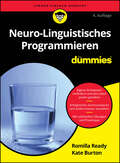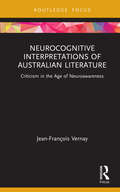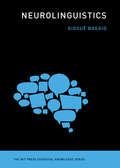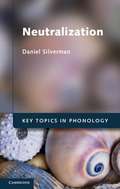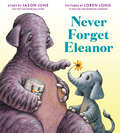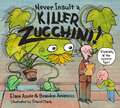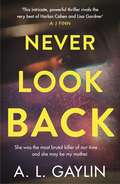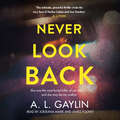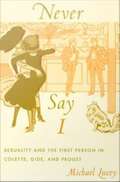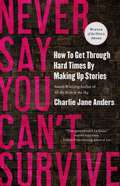- Table View
- List View
Neues von der Insel: Englische Literatur und Kultur der Frühen Neuzeit in deutscher Übersetzung (Übersetzungskulturen der Frühen Neuzeit #2)
by Jörg Wesche Silvia Serena Tschopp Franz FromholzerEin interdisziplinärer Band im Open-Access: Die Aufwertung der Volkssprachen in der Frühen Neuzeit führte zu einer Intensivierung und internationalen Öffnung der europäischen Übersetzungskultur. Der Gebrauch des Englischen bleibt in dieser Zeit allerdings weitgehend auf die Insel beschränkt, während die Sprache auf dem Kontinent noch wenig geläufig ist. Erst seit dem 18. Jahrhundert gewinnt sie an internationaler Bedeutung und steigt schließlich zur modernen Weltsprache auf. Der Band fokussiert auf die vormoderne Situation und untersucht in 19 literatur-, kunst-, philosophie- und frömmigkeitsgeschichtlichen Fallstudien die deutsche Rezeption der frühneuzeitlichen englischen Literatur und Kultur. Mit Blick auf das bislang unzureichend erforschte deutsch-englische Interaktionsfeld erhellt er ebenso ausgewählte Personen, Institutionen und Wissensfelder wie Werkübertragungen, Gattungstransformationen und Übersetzungspraktiken, die den bereits in dieser Zeit bemerkenswert dichten Austausch zwischen England und dem Alten Reich prägten. Welche Netzwerke und Medien ermöglichten z.B. die Rezeption einflussreicher Denker und Dichter wie Bacon, Hobbes oder Milton im deutschsprachigen Raum; wie kam es gleichsam im Mutterland des Protestantismus zu einer auffallend intensiven Übersetzung englischer Erbauungsliteratur; welche Rolle spielten Parallelübersetzungen oder auch Übersetzungen aus zweiter Hand, etwa dort, wo der kulturelle Transfer über eine dritte Sprache wie das Französische oder Niederländische erfolgte? Auf solche Fragen werden im Band neue Antworten gegeben.
Neural Mechanisms of Language
by Maria ModyThis important volume brings together significant findings on the neural bases of spoken language -its processing, use, and organization, including its phylogenetic roots. Employing a potent mix of conceptual and neuroimaging-based approaches, contributors delve deeply into specialized structures of the speech system, locating sensory and cognitive mechanisms involved in listening and comprehension, grasping meanings and storing memories. The novel perspectives revise familiar models by tracing linguistic interactions within and between neural systems, homing in on the brain's semantic network, exploring the neuroscience behind bilingualism and multilingual fluency, and even making a compelling case for a more nuanced participation of the motor system in speech. From these advances, readers have a more three-dimensional picture of the brain--its functional epicenters, its connections, and the whole--as the seat of language in both wellness and disorders. Included in the topics: #65533; The interaction between storage and computation in morphosyntactic processing. #65533; The role of language in structure-dependent cognition. #65533; Multisensory integration in speech processing: neural mechanisms of cross-modal after-effect. #65533; A neurocognitive view of the bilingual brain. #65533; Causal modeling: methods and their application to speech and language. #65533; A word in the hand: the gestural origins of language. Neural Mechanisms of Language presents a sophisticated mix of detail and creative approaches to understanding brain structure and function, giving neuropsychologists, cognitive neuroscientists, developmental psychologists, cognitive psychologists, and speech/language pathologists new windows onto the research shaping their respective fields.
Neural Representations of Natural Language (Studies in Computational Intelligence #783)
by Wei Liu Roberto Togneri Lyndon White Mohammed BennamounThis book offers an introduction to modern natural language processing using machine learning, focusing on how neural networks create a machine interpretable representation of the meaning of natural language. Language is crucially linked to ideas – as Webster’s 1923 “English Composition and Literature” puts it: “A sentence is a group of words expressing a complete thought”. Thus the representation of sentences and the words that make them up is vital in advancing artificial intelligence and other “smart” systems currently being developed. Providing an overview of the research in the area, from Bengio et al.’s seminal work on a “Neural Probabilistic Language Model” in 2003, to the latest techniques, this book enables readers to gain an understanding of how the techniques are related and what is best for their purposes. As well as a introduction to neural networks in general and recurrent neural networks in particular, this book details the methods used for representing words, senses of words, and larger structures such as sentences or documents. The book highlights practical implementations and discusses many aspects that are often overlooked or misunderstood. The book includes thorough instruction on challenging areas such as hierarchical softmax and negative sampling, to ensure the reader fully and easily understands the details of how the algorithms function. Combining practical aspects with a more traditional review of the literature, it is directly applicable to a broad readership. It is an invaluable introduction for early graduate students working in natural language processing; a trustworthy guide for industry developers wishing to make use of recent innovations; and a sturdy bridge for researchers already familiar with linguistics or machine learning wishing to understand the other.
Neuro-Futurism and Re-Imagining Leadership: An A-Z Towards Collective Liberation (Studies in Mobilities, Literature, and Culture)
by Kai Syng TanThis book is a rip-roaring manifesto that re-claims ways to think about and do ‘leadership’. Colliding mobilities, neuro-queering, the arts and culture, critical leadership studies, social justice, creative pedagogy, futurity and Daoist cosmology for the first time, the book proposes ‘neuro-futurism’ as a beyond-colonial, heuristic change-making tool-kit for individuals and institutions. Celebrating the Dangerous, Demeaning and Dirty labour of Deviant/Defiant culture-workers often side-lined in (leadership) scholarship across 26 break-neck chapters and 39 images, this book challenges white-supremacist-cis-het-neuro-normative-capitalist-patriarchal forms of power and knowledge. Punchy, punching up and pulling no punches, it is a call to arms, feet, sole-soul, to co-create tables/houses/worlds that profit (neuro-)divergent people, planet, poetry and play. The deadline is 2050, so we’re running out of time. Are you ready for an extra-ordinary adventure?
Neuro-Linguistisches Programmieren für Dummies (Für Dummies)
by Kate Burton Romilla ReadyÖffnen Sie Ihr Denken für neue M??glichkeiten! M??chten Sie andere Menschen besser verstehen und sich ihnen gegenüber besser verständlich machen? Dann ist dieses Buch genau das richtige für Sie. Romilla Ready und Kate Burton zeigen Ihnen, wie Sie mit NLP Ihre Kommunikation mit anderen erfolgreich gestalten k??nnen und Ihre Ziele leichter erreichen. Sie erfahren, was es mit »Landkarten«, »Ankern«, »Zeitreisen« oder »Rapport« auf sich hat, und werden schon bald merken, wie Sie einen neuen Blick auf Ihre Umwelt werfen und wie positiv sich Ihre Kommunikation mit anderen entwickelt. Sie erfahren Wie Sie Ihre Ziele mit neuer Energie und Überzeugung erreichen Wie Sie sich Geh??r für Ihre Botschaft verschaffen Wie Sie Zweifel überwinden und mehr Zufriedenheit erlangen
Neurocognitive Interpretations of Australian Literature: Criticism in the Age of Neuroawareness (Routledge Focus on Literature)
by Jean-François VernayThis unique book on neurocognitive interpretations of Australian literature covers a wide range of analyses by discussing Australian Literary Studies, Aboriginal literary texts, women writers, ethnic writing, bestsellers, neurodivergence fiction, emerging as well as high- profile writers, literary hoaxes and controversies, book culture, and LGBTIQA+ authors, to name a few. It eclectically brings together a wide gamut of cognitive concepts and literary genres at the intersection of Australian literary studies and cognitive literary studies in the first single-author volume of its kind. It takes Australian Literary Studies into the age of neuroawareness and provides new pathways in contemporary criticism.
Neuroethics and Cultural Diversity
by Michele FariscoThere is a growing discussion concerning the relationship between neuroethical reflections and cultural diversity, which is among the most impactful factors in shaping neuroethics, both as a scientific discipline and a social enterprise. The impacts of culture on science and its public perception are particularly relevant to neuroethics, which aims to facilitate the creation of an interface between neuroscience and society at large. Time is ripe for neuroethics to review the influence of the culturally specific contexts from which it originated (i.e. North America and Western Europe) and to also include other cultural perspectives in the discussion. This book illustrates a convergent approach among different cultures in identifying the main issues raised by neuroscience and emerging technologies. This should be taken as a starting point for advancing in the search for shared solutions, which are, if not definitive, at least sufficiently reliable to be translated into democratic deliberative processes.
Neurolinguistics (The MIT Press Essential Knowledge series)
by Giosue BaggioAn accessible introduction to the study of language in the brain, covering language processing, language acquisition, literacy, and language disorders.Neurolinguistics, the study of language in the brain, describes the anatomical structures (networks of neurons in the brain) and physiological processes (ways for these networks to be active) that allow humans to learn and use one or more languages. It draws on neuroscience, linguistics—particularly theoretical linguistics—and other disciplines. In this volume in the MIT Press Essential Knowledge series, Giosuè Baggio offers an accessible introduction to the fundamentals of neurolinguistics, covering language processing, language acquisition, literacy, and speech and language disorders. Baggio first surveys the evolution of the field, describing discoveries by Paul Broca, Carl Wernicke, Noam Chomsky, and others. He discusses mapping language in &“brain time&” and &“brain space&” and the constraints of neurolinguistic models. Considering language acquisition, he explains that a child is never a &“blank slate&”: infants and young children are only able to acquire specific aspects of language in specific stages of cognitive development. He addresses the neural consequences of bilingualism; literacy, discussing how forms of visual language in the brain differ from forms of auditory language; aphasia and the need to understand language disorders in behavioral, functional, and neuroanatomical terms; neurogenetics of language; and the neuroethology of language, tracing the origins of the neural and behavioral building blocks of human linguistic communication to the evolution of avian, mammalian, and primate brains.
Neurology for the Speech-Language Pathologist (Sixth Edition)
by Wanda G. WebbThe concise, easy-to-understand Neurology for the Speech-Language Pathologist, 6th Edition provides students and clinicians with a practical guide for the study and understanding of neurology in speech-language pathology (SLP). Correlated with clinical syndromes and diseases seen in SLP, it gives you a solid understanding of the nervous system, including: development of the nervous system, organization of the brain, protective mechanisms, descending motor and ascending sensory pathways, and cranial nerves. New content, case studies, and a strong clinical focus make this new edition essential as you move into practice.
Neuropsycholinguistic Perspectives on Language Cognition: Essays in honour of Jean-Luc Nespoulous (Explorations in Cognitive Psychology)
by Corine Astesano Mélanie JuclaThis book brings together experts from the fields of linguistics, psychology and neuroscience to explore how a multidisciplinary approach can impact on research into the neurocognition of language. International contributors present cutting-edge research from cognitive and developmental psychology, neuropsychology, psycholinguistics and computer science, and discuss how this contributes to neuropsycholinguistics, a term coined by Jean-Luc Nespoulous, to whom this book is dedicated.Chapters illustrate how researchers with different methods and theoretical backgrounds can contribute to a unified vision of the study of language cognition. Reinterpreting neuropsycholinguistics through the lens of each research field, the book demonstrates important attempts to adopt a comprehensive view of speech and language pathology.Divided into three sections the book covers: <P><P> <li>linguistic mechanisms and the architecture of language <li>the relationship between language and other cognitive processes <li>the assessment of speech and language disabilities and compensatory mechanisms. <P><P>Neuropsycholinguistic Perspectives on Language Cognition presents a unique contribution to cognitive science and language science, from linguistics to neuroscience. It will interest academics and scholars in the field, as well as medical researchers, psychologists, and speech and language therapists.
Neuroscience and Multilingualism
by Edna AndrewsHow are languages represented in the human brain? Ideas from neuroscience have increasingly been applied to the study of language, exploring the neural processes involved in acquisition, maintenance and loss of language and languages, and the interaction between languages in bi- and multilingual speakers. With a sharp focus on multilingualism, this culmination of cutting-edge research sheds light on this challenging question. Using data from a variety of experiments, this is the first book length study to offer a new neuroscientific model for analysing multilingualism. Alongside a comprehensive analysis of the theoretical and experimental contributions to the field, it presents new data and analysis obtained from a multilingualism fMRI study. It also includes a unique longitudinal study of second and third language acquisition combined with extensive empirically valid language proficiency data of the subjects. A must-read for researchers and advanced students interested in neurolinguistics, second language acquisition, and bi- and multilingualism.
Neuroscienze in aula. Sviluppo dell’intelligenza spaziale-visiva.
by Giuseppina De Vita Beatriz ManriqueL’obiettivo centrale del testo è quello di facilitare l’accesso al discorso sulla neuroscienza e come utilizzarla in aula, principalmente attraverso lo sviluppo dell’intelligenza spaziale-visiva proposta tanto da Gardner come da Beauport, due teorici delle intelligenze multiple. Si sviluppa l’uso della visualizzazione, l’abilità per arrivare all’astrazione degli spazi, come opzione di attività in classe progettate nell’ottica di un’educazione integrale. I temi presentati sono organizzati in nove parti: l’introduzione, un’intervista a una famosa maestra, la bilateralità cerebrale, un modello di analisi che parte dall’insegnamento delle lingue, il lavoro con le immagini, l’intelligenza visiva e la creatività, le immagini in aula, una proposta di attività con immagini e le conclusioni. In ciascuna parte si sviluppano differenti aspetti relazionati all’applicazione delle neuroscienze in una classe di lingue straniere, ma solo come esempio di applicazione poiché che l’obiettivo dell’autrice è di presentare, in maniera chiara, l’applicabilità della neuroscienza a tutte le aree di insegnamento e con molti esempi che facilitino l’estrapolazione dell’informazione ad altri campi. L’intervista con una maestra venezuelana di larghe vedute - Alicia Steiner – è uno dei migliori esempi, poiché mostra di fatto che quando si vuole, ci si prepara e si agisce, si raggiungono gli obiettivi. Le pratiche che vengono suggerite e gli esercizi che vengono descritti sono stati utilizzati in aula dalla stessa autrice, che offre la possibilità di espandere il loro utilizzo ad altre aree. Infine, nel testo sono raccolte varie attività visive come esempi di possibile utilizzo nel primo giorno di lezione. Le conclusioni includono, inoltre, riflessioni su tutto il processo del lavoro del docente secondo questo metodo.
Neutralization
by Daniel SilvermanThe function of language is to transmit information from speakers to listeners. This book investigates an aspect of linguistic sound patterning that has traditionally been assumed to interfere with this function – neutralization, a conditioned limitation on the distribution of a language's contrastive values. The book provides in-depth, nuanced and critical analyses of many theoretical approaches to neutralization in phonology and argues for a strictly functional characterization of the term: neutralizing alternations are only function-negative to the extent that they derive homophones, and most surprisingly, neutralization is often function-positive, by serving as an aid to parsing. Daniel Silverman encourages the reader to challenge received notions by carefully considering these functional consequences of neutralization. The book includes a glossary, discussion points and lists of further reading to help advanced phonology students consolidate the main ideas and findings on neutralization.
Never Better!: The Modern Jewish Picaresque
by Miriam UdelIt was only when Jewish writers gave up on the lofty Enlightenment ideals of progress and improvement that the Yiddish novel could decisively enter modernity. Animating their fictions were a set of unheroic heroes who struck a precarious balance between sanguinity and irony that author Miriam Udel captures through the phrase "never better." With this rhetorical homage toward the double-voiced utterances of Sholem Aleichem, Udel gestures at these characters' insouciant proclamation that things had never been better, and their rueful, even despairing admission that things would probably never get better. The characters defined by this dual consciousness constitute a new kind of protagonist: a distinctively Jewish scapegrace whom Udel denominates the polit or refugee. Cousin to the Golden Age Spanish pícaro, the polit is a socially marginal figure who narrates his own story in discrete episodes, as if stringing beads on a narrative necklace. A deeply unsettled figure, the polit is allergic to sentimentality and even routine domesticity. His sequential misadventures point the way toward the heart of the picaresque, which Jewish authors refashion as a vehicle for modernism--not only in Yiddish, but also in German, Russian, English and Hebrew. Udel draws out the contours of the new Jewish picaresque by contrasting it against the nineteenth-century genre of progress epitomized by the Bildungsroman. While this book is grounded in modern Jewish literature, its implications stretch toward genre studies in connection with modernist fiction more generally. Udel lays out for a diverse readership concepts in the history and theory of the novel while also explicating the relevant particularities of Jewish literary culture. In addressing the literary stylistics of a "minor" modernism, this study illuminates how the adoption of a picaresque sensibility allowed minority authors to write simultaneously within and against the literary traditions of Europe.
Never Enough Time: Communication and the Construction of Time in an Attention Economy (Routledge Research in Communication Studies)
by Brian H. SpitzbergNever Enough Time discusses the directional and irreversible nature of time, its relationship to information and entropy, the deep time history of communication from the genesis of language to today, and the extent to which we occupy time through our communication.Drawing together studies from a wide variety of disciplines and topics that provide quantitative estimates of how much daily time is expended communicating and relating to others, the author demonstrates that in an increasingly accelerating, mediated, and information-overloaded ecosystem, we spend most of our time, both socially and occupationally, engaged in various forms of communication. He examines the nature of time in the context of our increasingly overloaded and mediated information and communication ecosystem, the extent to which our increasing screen time displaces face-to-face interaction, and the implications this trend has for our quality and quantity of life, particularly for younger populations. In addition, a case is made for the importance of developing standardized measures of time, made all the more feasible with digital technologies already available for quantifying behavior at population scales.This book will appeal to graduate students, scholars, and researchers interested in time, communication theory, new media and media studies, and communication and personal relationships.
Never Forget Eleanor
by Jason JuneThis poignant story from New York Times bestselling author Jason June and #1 New York Times bestselling illustrator Loren Long reminds us of the life-changing power of words and the ways we remember the ones we love who've been affected by Alzheimer's or dementia. Perfect for fans of Drawn Together and The Rough Patch. Elijah loves spending time with his grandma Eleanor. She knows all the best words to answer tricky crossword puzzles and to tell the most beautiful stories to her family and friends.Everyone calls her “Never Forget Eleanor” because she remembers every word she reads and person she meets. Lately though, Elijah has started to notice Grandma Eleanor forgetting little things.So when Grandma Eleanor doesn’t show up for her Saturday story session, Elijah will need to find a way to use her favorite words and become the storyteller himself to bring her home.
Never Insult a Killer Zucchini
by Elana Azose Brandon AmancioThis is one science fair you&’ll never forget! When Mr. Farnsworth, the science-fair judge, declares that he loves zucchinis, the Killer Zucchini is smitten. As the judge makes his way through the exhibits alphabetically—A (antimatter), B (bionic limb), C (cloning)—the Killer Zucchini tries to show his affection. But when Mr. F gets to K and admits he likes to eat zucchini with ranch dressing, the Killer Zucchini gets steamed and attempts to exact his revenge on the snack-loving judge using the other science-fair projects as his means to an end. Hilarious havoc ensues as the entire science fair is destroyed by his wrath. Engaging backmatter provides the science behind the science fair entries created by the characters in the story.
Never Let a Fool Kiss You or a Kiss Fool You
by Mardy GrotheWhat do Mae West, John F. Kennedy, Victor Hugo, and H. L. Mencken have in common? They all indulged in chiasmus-a literary device in which word order is reversed to hilarious or poignant effect. When Mae West said, "It's not the men in my life, it's the life in my men," she was using chiasmus; when John F. Kennedy said, "Ask not what your country can do for you, ask what you can do for your country," he was doing the same. Dr. Mardy Grothe has compiled hundreds of examples of chiasmus in this whimsically illustrated collection, bringing this witty and thought-provoking device out of obscurity and into the public imagination. "There is plenty of delight in this overdue collection. " (Houston Chronicle)
Never Look Back: She was the most brutal serial killer of our time. And she may have been my mother.
by A.L. Gaylin'Aflame with tension. An intricate, powerful thriller - rivals the very best of Harlan Coben and Lisa Gardner' AJ Finn, author of THE WOMAN IN THE WINDOW*****************She was the most brutal killer of our time. And she may have been my mother...When website columnist Robin Diamond is contacted by true crime podcast producer Quentin Garrison, she assumes it's a business matter. It's not. Quentin's podcast, Closure, focuses on a series of murders in the 1970s, committed by teen couple April Cooper and Gabriel LeRoy. It seems that Quentin has reason to believe Robin's own mother may be intimately connected with the killings.Robin thinks Quentin's claim is absurd. But is it? The more she researches the Cooper/LeRoy murders herself, the more disturbed she becomes by what she finds. Living just a few blocks from her, Robin's beloved parents are the one absolute she's always been able to rely upon, especially now amid rising doubts about her husband and frequent threats from internet trolls. Robin knows her mother better than anyone.But then her parents are brutally attacked, and Robin realises she doesn't know the truth at all...*****************'Completely absorbing with a knock-out twist' Harlan Coben'Gaylin is an expert at acute emotional observation combined with seamless plotting' Alex Marwood'AL Gaylin is at the top of her game, crafting exhilarating and audacious crime novels that are both rich in character and rivetingly told. They are, quite simply, not to be missed' Megan Abbott'AL Gaylin is a storyteller guaranteed to keep you up at night' Laura Lippman'AL Gaylin is a great storyteller' Mark Billingham'A fiendishly well-told thriller that deepens its grip the faster you read - I loved it' Louise CandlishIf you love Serial, S-Town, Clare Mackintosh, Cara Hunter, KL Slater or Lisa Jewell, you will be utterly gripped by this psychological thriller with a twist you'll never see coming...
Never Look Back: She was the most brutal serial killer of our time. And she may have been my mother.
by A.L. GaylinShe was the most brutal killer of our time. And she may have been my mother...When website columnist Robin Diamond is contacted by true crime podcast producer Quentin Garrison, she assumes it's a business matter. It's not. Quentin's podcast, Closure, focuses on a series of murders in the 1970s, committed by teen couple April Cooper and Gabriel LeRoy. It seems that Quentin has reason to believe Robin's own mother may be intimately connected with the killings.Robin thinks Quentin's claim is absurd. But is it? The more she researches the Cooper/LeRoy murders herself, the more disturbed she becomes by what she finds. Living just a few blocks from her, Robin's beloved parents are the one absolute she's always been able to rely upon, especially now amid rising doubts about her husband and frequent threats from internet trolls. Robin knows her mother better than anyone.But then her parents are brutally attacked, and Robin realises she doesn't know the truth at all...
Never Say I: Sexuality and the First Person in Colette, Gide, and Proust
by Michael LuceyNever Say I reveals the centrality of representations of sexuality, and particularly same-sex sexual relations, to the evolution of literary prose forms in twentieth-century France. Rethinking the social and literary innovation of works by Marcel Proust, Andr Gide, and Colette, Michael Lucey considers these writers' production of a first-person voice in which matters related to same-sex sexuality could be spoken of. He shows how their writings and careers took on political and social import in part through the contribution they made to the representation of social groups that were only slowly coming to be publicly recognized. Proust, Gide, and Colette helped create persons and characters, points of view, and narrative practices from which to speak and write about, for, or as people attracted to those of the same sex. Considering novels along with journalism, theatrical performances, correspondences, and face-to-face encounters, Lucey focuses on the interlocking social and formal dimensions of using the first person. He argues for understanding the first person not just as a grammatical category but also as a collectively produced social artifact, demonstrating that Proust's, Gide's, and Colette's use of the first person involved a social process of assuming the authority to speak about certain issues, or on behalf of certain people. Lucey reveals these three writers as both practitioners and theorists of the first person; he traces how, when they figured themselves or other first persons in certain statements regarding same-sex identity, they self-consciously called attention to the creative effort involved in doing so.
Never Say You Can't Survive
by Charlie Jane AndersWINNER OF THE 2022 HUGO AWARD FOR BEST RELATED WORKFrom Charlie Jane Anders, the award-winning author of novels such as All the Birds in the Sky and The City in the Middle of the Night, this is one of the most practical guides to storytelling that you will ever read.The world is on fire.So tell your story.Things are scary right now. We’re all being swept along by a tidal wave of history, and it’s easy to feel helpless. But we’re not helpless: we have minds, and imaginations, and the ability to visualize other worlds and valiant struggles. And writing can be an act of resistance that reminds us that other futures and other ways of living are possible.Full of memoir, personal anecdote, and insight about how to flourish during the present emergency, Never Say You Can’t Survive is the perfect manual for creativity in unprecedented times.At the Publisher's request, this title is being sold without Digital Rights Management Software (DRM) applied.
Neverending Stories: Toward A Critical Narratology (Princeton Legacy Library #1209)
by Maria Tatar Ann Fehn Ingeborg HoestereyIn these compelling new essays, leading critics sharpen our understanding of the narrative structures that convey meaning in fiction, taking as their point of departure the narratological positions of Dorrit Cohn, Grard Genette, and Franz Stanzel. This collection demonstrates how narratology, with its attention to the modalities of presenting consciousness, offers a point of entry for scholars investigating the socio-cultural dimensions of literary representations. Drawing from a wide range of literary texts, the essays explore the borderline between fiction and history; explain how characters are constructed by both author and reader through the narration of consciousness; show how gender shapes narrative strategies ranging from the depiction of consciousness through intertextuality to the representation of the body; address issues of contingency in narrative; and present a debate on the crucial function of person in the literary text. The contributors are Stanley Corngold, Gail Finney, Kte Hamburger, Paul Michael Ltzeler, David Mickelsen, John Neubauer, Thomas Pavel, Jens Rieckmann, Shlomith Rimmon-Kenan, Judith Ryan, Franz Stanzel, Susan Suleiman, Maria Tatar, David Wellbery, and Larry Wolff.
Nevile and the Duppy Master
by Debbie JacobThis second book in the Nevile series takes the band of companions deeper into the mystery of the evil king's rise to power. Can he be brought to justice?Suspicion looms large and deception rules the day as Nevile plots to depose the evil king of Aribbea in the year 2222. To succeed, the famous bridge builder must convince Nina, A.T. and Hunn Dread to support his mission, but everyone feels torn in different directions. Nina's bond with Hanuman the monkey leads her on a new path in life; A.T. is content with power over his own canton and Hunn Dread emerges as Nevile's rival for Nina's affection. As usual, Pierre the bacoo is sneaking off to stir up trouble with his lies. Success now depends on Nevile questioning the Royal Record Keeper to unlock the mystery of the keys in the treasure chest Nina discovered when she first found land and changed the course of the three bridgers' lives. Nevile's first test comes in Xaymaca's elfin forest where duppies confront Nevile's party. Will Nevile unite his friends, Papa Bois' folk, the bridgers and the salt miners to overthrow the king? Will he feel forced to choose between Nina and Seamstress Number 2, who once saved his life? Will he discover SN2's secret? Excitement mounts and tempers flare as Nevile builds his fighting force joined by a second Guyanese genie, a duppy and a forest creature. Will Nevile win freedom for Aribbea from the king?
Nevile and the Duppy Master (Caribbean Modern Classics)
by Debbie JacobThis second book in the Nevile series takes the band of companions deeper into the mystery of the evil king's rise to power. Can he be brought to justice?Suspicion looms large and deception rules the day as Nevile plots to depose the evil king of Aribbea in the year 2222. To succeed, the famous bridge builder must convince Nina, A.T. and Hunn Dread to support his mission, but everyone feels torn in different directions. Nina's bond with Hanuman the monkey leads her on a new path in life; A.T. is content with power over his own canton and Hunn Dread emerges as Nevile's rival for Nina's affection. As usual, Pierre the bacoo is sneaking off to stir up trouble with his lies. Success now depends on Nevile questioning the Royal Record Keeper to unlock the mystery of the keys in the treasure chest Nina discovered when she first found land and changed the course of the three bridgers' lives. Nevile's first test comes in Xaymaca's elfin forest where duppies confront Nevile's party. Will Nevile unite his friends, Papa Bois' folk, the bridgers and the salt miners to overthrow the king? Will he feel forced to choose between Nina and Seamstress Number 2, who once saved his life? Will he discover SN2's secret? Excitement mounts and tempers flare as Nevile builds his fighting force joined by a second Guyanese genie, a duppy and a forest creature. Will Nevile win freedom for Aribbea from the king?




